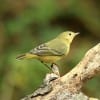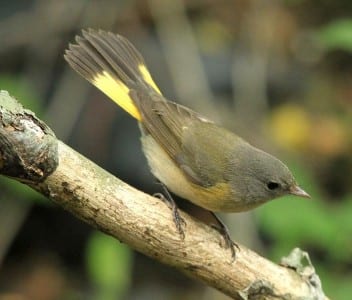 by Jim Stevenson,
by Jim Stevenson,
While male Yellow Warbler adults are very yellow, immature birds lack the eye-popping color possessed by their dads. Still, without and real markings, including eye-stripes or eye-rings, this is just a Yellow. This species is not only common in much of North America; it has races which have colonized such areas as Mangrove islands and even the Galapagos.

American Redstarts are one of the best examples of flash colors in the bird world. The orange “windows” in the wings and tail spook hidden bugs off vegetation and make the redstarts aware of them. They also have rictal bristles (“whiskers” on the face) to help haul in flying insects, although they’re hard to see on this one.

While you can see the rictal bristles easier here, you are also struck by the wing and tail patches being yellow in females, not the red of the males. This is not uncommon; look at the red male tanagers with yellow females (or orange orioles with yellow females). You can also see the bill is flatter than other warblers, giving them a wider instrument to grab flying insects.

Common Yellow throats are an offbeat warbler, and actually a group of several species in Central America. The mask hides the eye and makes hunting for bugs easier, and they all sneak around in thick vegetation. Their habitat in the US is typically marshes, unlike the woodland haunts of most warblers. You can hear them singing, "wichita wichita wichita".

One species more common back East, or even in spring, is the Chestnut-sided Warbler. The female lacks any chestnut in fall and many struggle with the ID. The pea green top and bold eye-ring help, plus they have strong wing bars. Unlike many migrants, these birds are just about equally common spring and fall.

OK, I admit, it’s a pretty good picture. 😉 This is the Magnolia Warbler, a species much more common in the second half of the migration. The yellow underneath and blue-gray on top makes them an easy ID, once you eliminate the Canada Warbler that migrates the first half of the migration. Magnolias also have a bit of a greenish patch in the middle of the back, somewhat reminiscent of the scrub jay group.

Curiously, another group of warblers with a greenish area in the middle of the back is the parulas, and the North American species is the Northern Parula (Tropicals are found from South Texas, southward). The blue back and yellow throat are diagnostic in parulas, especially when combined with the small size and lack of streaking. This is a very common bird throughout the East in moist forests, issuing its ascending trill from late March to June.

One of our few winter resident warblers is the Orange-crowned, a bird with a very large North American range (one of eight warblers that nest as far north as Alaska). This species is dull green with a gray head and dull white eye-ring. It also has a curious, light feather at the edge of the bend of the wing, a better field mark than you might think! They also have a thick, sharp beak for gouging berries.

Palm Warblers are uncommon in Texas, though they are abundant the closer one gets to Florida. There are some tall grassy areas along the coast (like Indian Beach) where they are found, including around the boardwalk at Anahuac NWR. Their plumage is rather plain but their incessant tail-bobbing is only duplicated by the Prairie Warbler (with a surprisingly similar distribution). Note the aberrant feather sticking out of this bird’s deformed left wing. Political buffs, don’t go there…) Tennessee Warbler females are green as a gourd, lacking the gray head of the males. The light supercilium eliminates any thought of a Yellow Warbler, but no Yellow has ever been this green, anyway. These often are found in small flocks together, as their flight speed seems to be faster than other warblers, often making them fly together.


A dainty, lovely little bird is the Wilson’s Warbler, French cap and all. They are often detected by their “kissing” calls, and usually stay low enough they can be easily seen working the edge of bushes. This species ranges far into the West and the only State in the Lower 48 lacking any real numbers of them is Florida.

While male Wilson’s Warblers are easy to ID, with their black “French” cap, these females are less obvious. Still, you can see the light supercilium over the eye, a field mark not found in Yellow Warblers. They also tend to cock their tails and make little kissing notes. These and Nashville are extremely common on the coast in fall but mostly inland in spring.

Poor picture, but this Blackburnian Warbler is a species not seen much in fall on the Texas Coast. The orange eye-stripe and chest are good field marks. Many warblers are more common either in Florida (aka back East) or Texas. This is dependent on their wintering grounds, as those who winter in Central America migrate more through Texas and those heading to the West Indies choose a Floridian route.

While male Yellow Warbler adults are very yellow, immature birds lack the eye-popping color possessed by their dads. Still, without and real markings, including eye-stripes or eye-rings, this is just a Yellow. This species is not only common in much of North America; it has races which have colonized such areas as Mangrove islands and even the Galapagos.

 Posted in
Posted in 
























